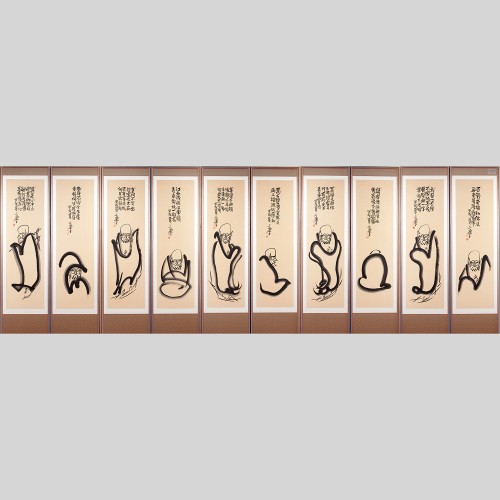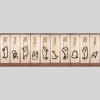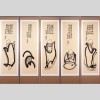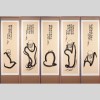본문
석정 스님은 우리 시대를 대표하는 불화(佛畵) 작가로, 송광사에서 출가하여 김일섭 스님 문하(門下)에서 불화를 수학(受學) 하였습니다. 이후 반세기 이상 전국 사찰의 불화, 단청, 불사에 참여하며 전통을 계승하는 동시에 현대적 미감을 결합한 독자적 화풍을 확립한 화승입니다.
달마도는 선종(禪宗)의 시조인 달마대사를 그린 작품으로, 불교 회화 중에서도 선종 정신을 상징적으로 드러내는 주제입니다. 일반 불화가 장엄한 표현을 중시하는 데 비해, 달마도는 단순하면서도 강렬한 표현으로 직관적 깨달음의 세계에 이르게 합니다. 간결한 필선과 검소한 달마의 모습은 선의 가르침을 시각화합니다.
석정 스님의 달마도는 전통 선화 양식을 따르면서도 특유의 화풍이 드러납니다. 석정 스님은 수행자이자 화승(畵僧)으로서의 내면을 간결하고 힘 있는 붓질에 응축하여 작품을 그려냈습니다. 단순한 달마도를 넘어 과감한 붓질과 선이 어우러져 수행의 경지를 직관적으로 드러냅니다. 달마를 표현한 담백한 선과 부드러운 시선 처리는 달마의 고요한 내면을 집중적으로 표현하며, 여백과 순간의 붓 터치가 긴장감을 형성해 자연스러운 몰입을 유도합니다.
과도한 장식과 상징을 배제한 ‘무심(無心)’의 화법은 선의 본질을 즉각 나타냅니다. 이는 석정 스님이 평생 실천해 온 ‘이화입도(以畵入道)’와 ‘선화일치(禪畵一致)’ 정신이 잘 반영된 부분으로 보입니다.
■ 석정 스님 약력
1928 강원도 고성 신북면 출생
1940 송광사 출가
1941 김일섭 스님 문하 불화 수학
1969 서울·부산 《선서화전》 개최, 불교미술전람회 심사위원 활동
1976 부산 장전동 선주산방 건립 및 정착
1992 중요무형문화재 제48호 ‘단청장’ 지정
1995 『한국의 불화』 40권 발간 시작 (3,156점 수록)
2006 중요무형문화재 제118호 ‘불화장’ 지정
2007 『한국의 불화』 40권 발간 완료
2007 문화포장 수상, 서울·부산 《연묵전》 개최
2024 통도사 성보박물관에서 공개 시연 및 법문
2024 입적
2025 서울 세종문화회관 《석정전》 및 부산 국제문화회관 《석정전》 순회전 개최
2025 『석정서화집』, 『석정시문집』, 『한국의 불화』 출판기념회 개최
55년 이상, 전국 주요 사찰(송광사, 범어사, 통도사, 표충사, 봉암사 등) 불화 완성 및 조성 작업 참여
━━━━━
石鼎僧人是当代最具代表性的佛画艺术家之一。在松广寺出家,师从著名佛画僧金日燮僧人,系统学习佛画艺术。此后半个多世纪间,石鼎僧人参与全国各大寺院的佛画、丹青和彩绘佛事,既延续了传统技法,也结合现代审美,确立了其独特的绘画风格,成为将修行与艺术合一的代表性画僧。
达摩图描绘的是禅宗初祖达摩大师,是佛教绘画中具有象征性的主题之一。相较于强调庄严与华丽的传统佛画,达摩图更注重以简练而有力的表现手法,引导观者进入直观觉悟的境界。以简练笔触勾勒出的朴素达摩形象,生动体现了禅宗教义的核心精神。
石鼎僧人的达摩图虽承袭传统禅画的样式,却展现出其独特的艺术风格。作为一位修行者兼画僧,将内在的修为凝聚于简练而有力的笔触之中,赋予作品深沉的精神气质。其作品不止于描绘达摩形象,更以果断奔放的笔势与流畅线条,直观展现出修行中的境界体悟。运用朴素的线条与柔和的目光描绘达摩,聚焦于其沉静内在世界的表达。画面中的留白与转瞬即逝的笔触形成张力,引导观者沉浸于达摩的禅意之中。
摒弃繁复装饰与象征的“无心”画法,直接呈现出禅的本质。这种表达方式,正体现了石禅法师一生奉行的“以画入道”与“禅画一致”的修行精神。
■ 石鼎僧人 介绍
1928年 出生于韩国江原道高城郡新北面
1940年 于松广寺出家
1941年 师从金日燮僧人,学习佛教绘画技艺
1969年 在首尔与釜山举办《禅书画展》,并担任佛教美术展览会评审委员
1976年 在釜山长箭洞建立“禅主山房”,定居于此,潜心佛画创作
1992年 被指定为韩国重要非物质文化遗产第48号“丹青匠”
1995年 启动《韩国佛画》40卷大型图录编纂工程(共收录3,156件作品)
2006年 被追加指定为韩国重要非物质文化遗产第118号“佛画匠”
2007年 《韩国佛画》全40卷编纂完成
2007年 荣获文化褒章,并于首尔与釜山举办《烟默展》
2024年 于通度寺圣宝博物馆举行公开示范与法语开示
2024年 入寂
2025年 在首尔世宗文化会馆与釜山国际文化会馆举办《石鼎展》巡回展
2025年 举行《石鼎书画集》、《石鼎诗文集》、《韩国佛画》出版纪念会
在长达55年以上的艺术生涯中,石鼎僧人参与并主导了韩国众多主要寺院(如松广寺、梵鱼寺、通度寺、表忠祠、凤岩寺等)的佛画绘制与重修工程
━━━━━
Monk Seokjeong is a leading Buddhist painter of our time. He entered monastic life at Songgwangsa Temple and studied Buddhist painting under Monk Kim Il-seop. For over half a century, he has contributed to temple murals, decorative coloring, and Buddhist projects across Korea, establishing a unique painting style that blends tradition with contemporary aesthetics.
The Dalma-do (paintings of Bodhidharma) portray Bodhidharma, the founder of Seon (Zen) Buddhism, and are a symbolic genre in Buddhist art that conveys the essence of Seon philosophy. Unlike typical Buddhist paintings that emphasize grandeur and ornamentation, Dalma-do is marked by simplicity and bold expression, leading viewers toward intuitive enlightenment. The minimal brushwork and austere depiction of Bodhidharma visualize the teachings of Seon.
Seokjeong’s Dalma-do follows the traditional Seon painting style while reflecting his distinctive artistic voice. As both a practitioner and painter-monk, Seokjeong condenses his inner discipline into concise, powerful brushstrokes. Beyond mere representation, the dynamic lines and expressive energy reveal a profound meditative state. His delicate rendering of Bodhidharma’s calm gaze and unadorned figure focuses on inner tranquility, while the interplay of negative space and spontaneous brush touches evokes tension and draws the viewer into a contemplative experience.
By excluding excessive decoration and symbolism, his mushim (no-mind) painting style expresses the very core of Seon. This approach embodies Seokjeong’s lifelong devotion to the ideals of “painting as the path” and “harmony between Seon and painting”.
■ Biography of Monk Seokjeong
1928: Born in Sinbuk-myeon, Goseong, Gangwon-do
1940: Ordained at Songgwangsa Temple
1941: Studied Buddhist painting under Monk Kim Il-seop
1969: Held Zen Calligraphy and Painting Exhibition in Seoul and Busan; served as judge for Buddhist Art Exhibition
1976: Built and settled at Seonju Hermitage in Jangjeon-dong, Busan
1992: Designated as Important Intangible Cultural Heritage No. 48 (Dancheong Artisan)
1995: Began publication of Buddhist Paintings of Korea (40 volumes, 3,156 works cataloged)
2006: Designated as Important Intangible Cultural Heritage No. 118 (Buddhist Painting Artisan)
2007: Completed publication of Buddhist Paintings of Korea (40 volumes)
2007: Received the Order of Cultural Merit; held Yeonmuk Exhibition in Seoul and Busan
2024: Gave a public demonstration and Dharma talk at the Tongdosa Seongbo Museum
2024: Passed away
2025: Touring Seokjeong Retrospective held at Seoul Sejong Center and Busan International Cultural Center
2025: Publication ceremonies for Collected Calligraphy and Paintings of Seokjeong, Collected Poems of Seokjeong, and Buddhist Paintings of Korea
For over 55 years, Monk Seokjeong participated in the creation and restoration of Buddhist paintings at major temples across Korea, including Songgwangsa, Beomeosa, Tongdosa, Pyochungsa, and Bongamsa.



